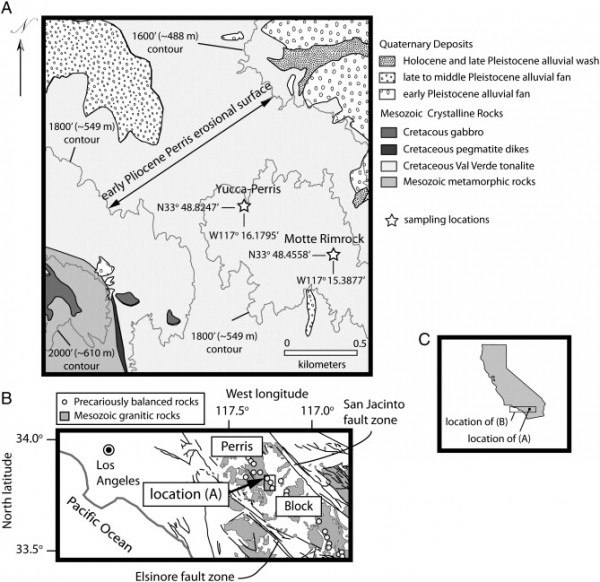A new paper representing a case study illustrating how the generalized model for the development of the regolith first proposed by Nesbitt et al. (1997) and Nesbitt and Markovics (1997), and supported by many other investigations, can be used as a framework for reconstructing the regolith from erosionally exhumed incomplete sections.

Reconstructing the regolith from erosionally exhumed corestone and saprock derived from the Cretaceous Val Verde tonalite, Peninsular Ranges, southern California, USA: A case study
G.H. Girty, K.L. Gebhart, C.T. Replogle, N. Morton, J.W. Purcell, J.R. Parizek, T. Carrasco, R. Errthum, K. Groover
Department of Geological Sciences, San Diego State University, San Diego, CA 92182, USA
Abstract
In temperate zones, an idealized profile of the regolith would consist of in descending order and decreasing weathering intensity, zones I, II, III, and IV. Each zone is characterized by a distinctive mineralogy and chemistry that reflects reactions between rocks and downward percolating fluids. Utilizing these principles, we attempted to reconstruct the original position within the regolith of erosionally exhumed corestone and saprock derived from the Cretaceous Val Verde tonalite at Yucca-Perris and Motte Rimrock, southern California.
Chemical index of alteration (CIA) values derived from saprocks at both sites range from 0.49 to 0.50. At Yucca-Perris, average weathering intensity values (t) are 0.03 ± 0.12 and at Motte Rimrock are 0.03 ± 0.02. Clay minerals at Yucca-Perris are smectite, kaolinite, and illite, and at Motte Rimrock vermiculite, kaolinite, and illite. No statistically significant loss of elemental mass or changes in bulk mass and LOI (i.e., water + volatiles) occurred at Yucca-Perris, while at Motte Rimrock a significant increase in LOI is evident. We interpret the significant increase in LOI to reflect the stronger intensity of weathering at Motte Rimrock where incongruent dissolution was responsible for modest leaching and removal of Na, Ba, and Sr masses from plagioclase. The mass of La at Yucca-Perris, and the masses of Er, Tm, and Yb at Motte Rimrock were increased. Such increases imply that prior to removal of the overlying soil and upper parts of the regolith, acidic solutions mobilized the rare earth elements, and then transported them downward into the lower regolith where increasing pH resulted in their precipitation, exchange, and adsorption onto mineral surfaces. The above data suggest that at Motte Rimrock the sampled corestone and saprock formed initially at the transition between the upper and lower parts of zone II and at Yucca Perris at the transition between the upper and lower parts of zone III.


